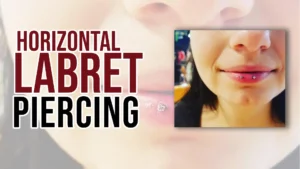The process of getting your ears pierced is frequent changes and safe. A fresh piercing, however, is an open wound that requires treatment and excellent cleaning. You might be able to treat a minor infection using over-the-counter medications.
However, you might require a healthcare professional’s assistance for infections that are more severe. Read our blog post to know how you can treat it!
What to Know About Infected Cartilage Piercing?
A hole is made through the cartilage of the middle or upper ear or the lobe of your ear. Red, bloated, sore, heated, itchy, or discomfort are all symptoms of an infected ear piercing. Pus that is white, yellow, or greenish may sometimes flow from the Piercing.
Upper ear infections can sometimes be very significant, and those who get them are much more likely to have piercings there.
How Are Common Infected Cartilage Piercings?
Millions of people who already have their ears (and other parts of their body) pierced don’t typically have any major issues. However, for new piercings, mild discomfort and infections are frequent. In most cases, infections don’t progress too much and get better soon.
The earlobes have a healthy blood supply and are fat and fleshy. They recover quickly, which reduces the risk of earlobe disease. The cartilage in the upper ear is a dense, hard tissue that receives less blood.
How are Infected Cartilage Piercings treated?
A number of therapies may be suggested by your doctor to aid in the healing of an infected ear piercing.
- Putting a warm compress on the cartilage or earlobe that is infected.
- Using sterile saline to rinse the infected earlobe.
- Applying an antibiotic cream to the term.
- Using oral antibiotics for infections that are more serious.
Ways to prevent a pierced cartilage infection?
The reliable way to avoid infection is to take good care of your skin jewelry.
- Wear your earrings day and night when your piercings are entirely healed.
- Wash your hands when touching the earlobes or cartilage.
- Use a gentle soap or cleanser to wash the Piercing twice daily.
- Rub alcohol or an antibacterial ointment on the affected area twice a day.
- After cleaning the Piercing with petroleum jelly or antibiotic ointment, gently rotate the earrings every day.
Ear piercing is often a quick, threatening process. Be certain to visit a skilled piercer who follows sanitary best practices. Use earrings just the once your latest piercings have healed completely, and keep them clean. Be patient and take action to prevent an illness right away. You’ll be able to enjoy healthy piercings for many years to come.
Get your ears pierced by a professional to prevent infection. Not at your home. A good inquiry to make is how to avoid infections. Ask if their gear is sterile as well. Verify that the earrings they wear were just removed from a product, sterile container.
After getting your ears pierced, clean them each day with the supplied rinse or sterile saline. Basically, turn your jewelry as this might injure the skin and spread infection. Without taking out the earring, you can clean the area around the Piercing.
Despite the desire, refrain from handling or playing with the jewelry excessively. This is a typical way that infection begins.
Conclusion:
Someone considering purchasing a piercing wouldn’t expect that it would become infected, right? Thoughts of butterflies and rainbows are what we all like to think about, but life isn’t always a comfortable place.
Even though having your ears pierced is a simple and safe procedure when done by a licensed and certified piercer. It can occasionally become infected. Things might grow bad if an infection isn’t detected on a timely basis.
As a result, a fresh piercing should always be treated like a new wound. Maintain it, keep it clean, and watch out for infection. Inflammation and infection are particularly common with cartilage piercings. Hence, you must take great care.
FAQs:
How Do Infectious Ear Piercings Appear?
A cartilage piercing is a hole made in the middle or upper ear cartilage. You’ll know the area is infected if it becomes painful, itchy, sore, swollen, warm, or red. Moreover, the location occasionally discharges a greenish, yellowish, or whitish material.
What happens next if the infection Isn’t treated?
You are at risk of compromising your health and your safety if you ignore an ear infection in the hope that it will go away on its own. If left untreated, an infection will develop until it develops into an abscess. Systemic infection is what happens when the infection slowly spreads to the rest of your body. A fatal systemic disease occurs with time.
How frequent are infected ear piercings?
Earlobes have healthy blood flow, which causes them to recover fast and lower their risk of illness. The ear cartilage, on the other hand, has less blood flow and is heavier and thicker. Of course, cartilage piercings are more likely to become infected.





